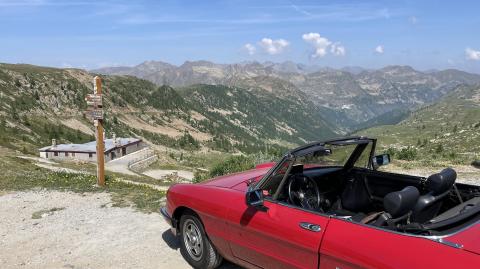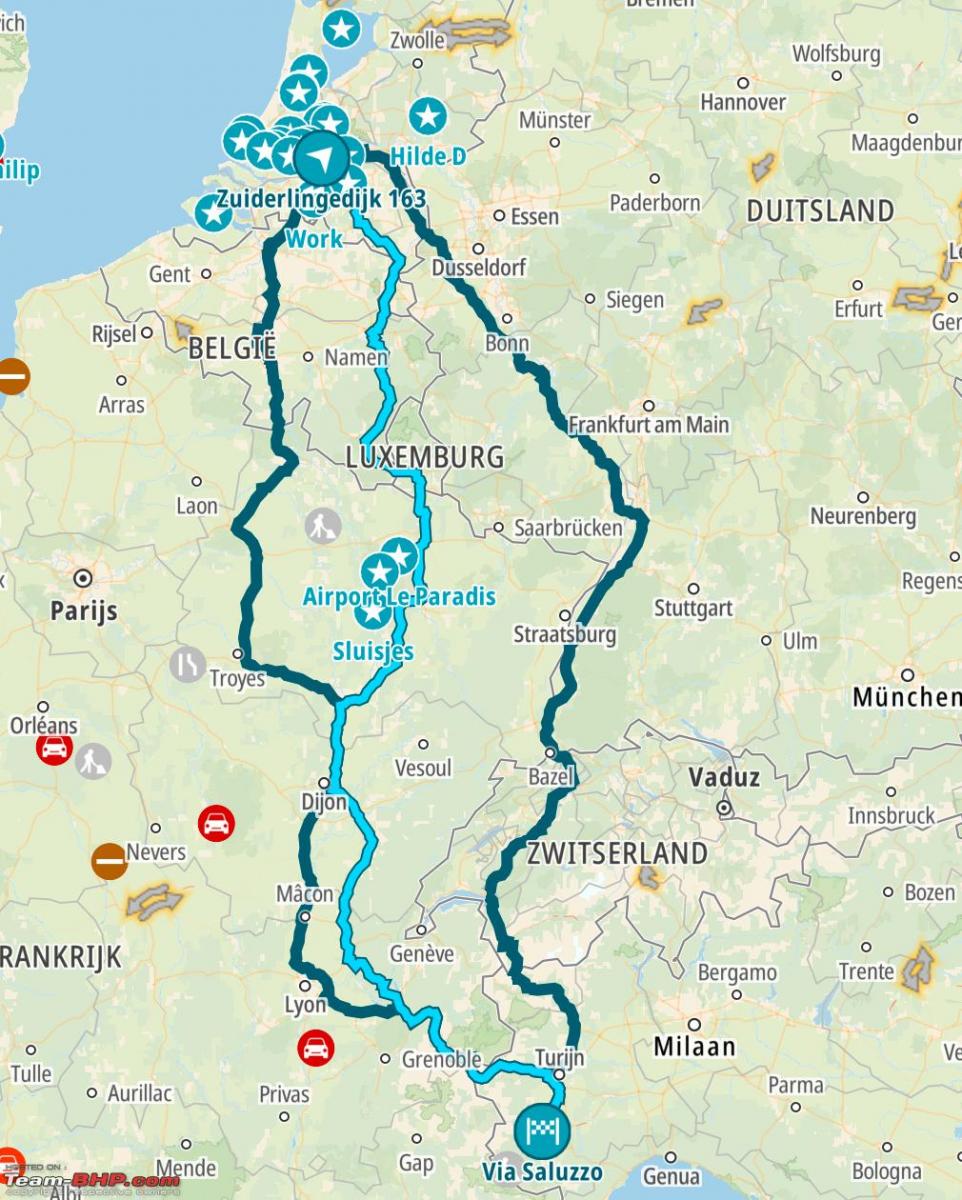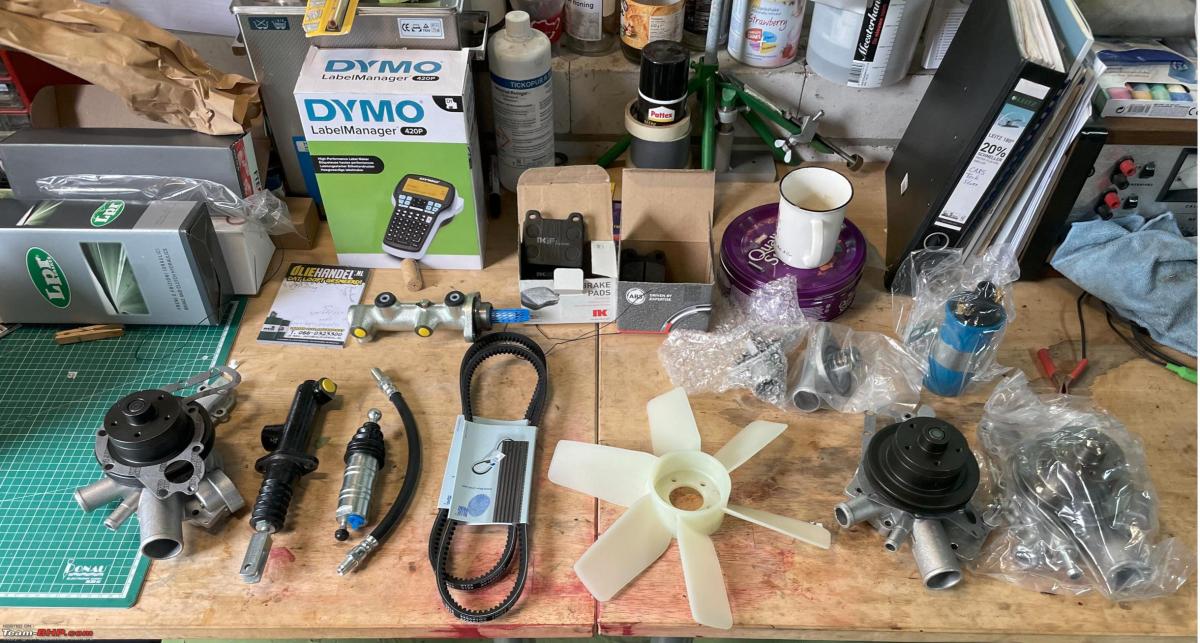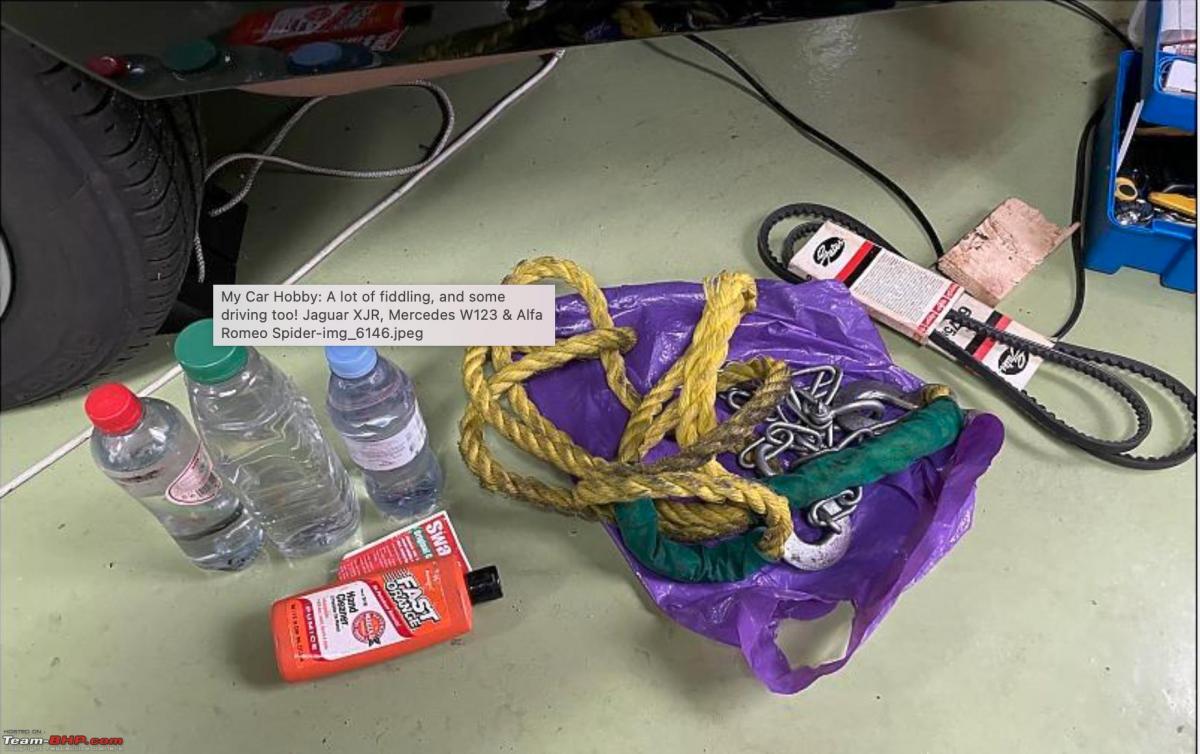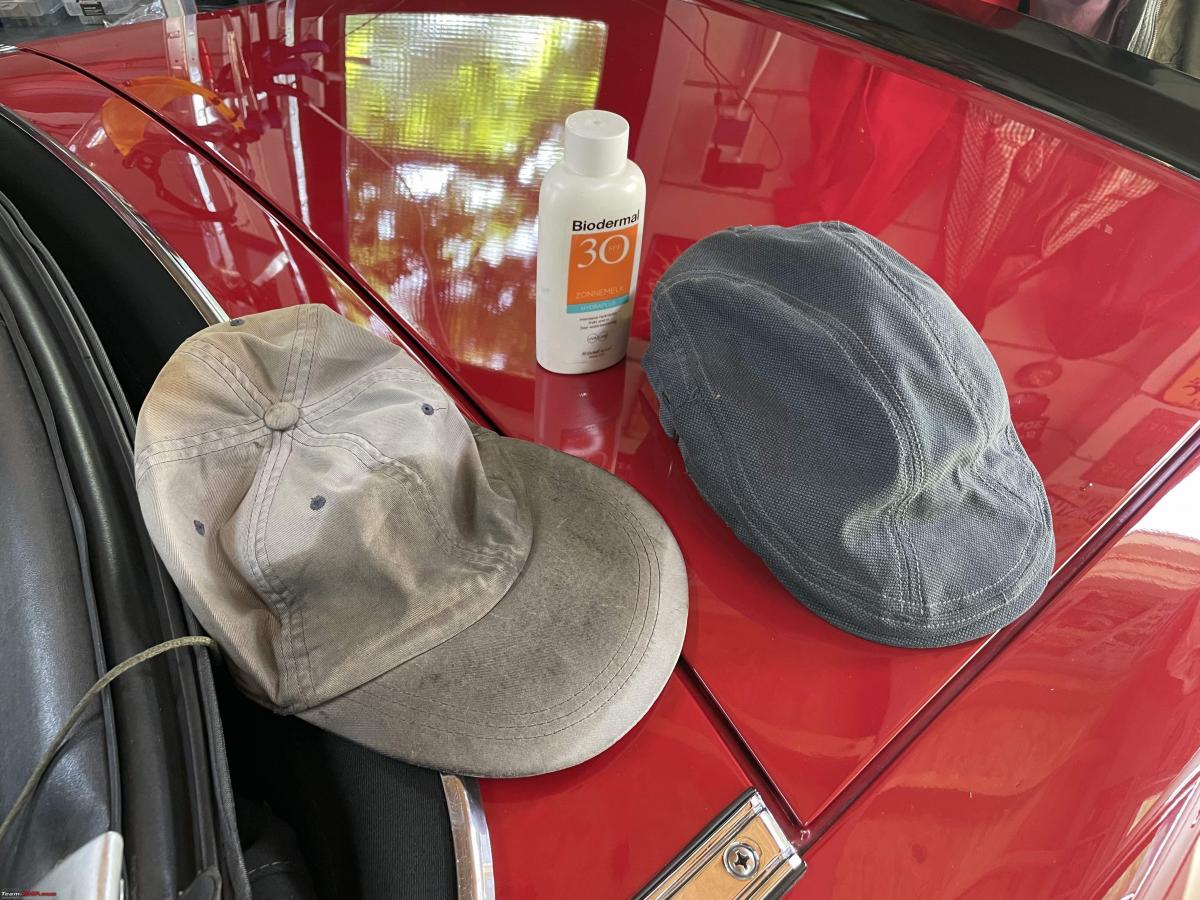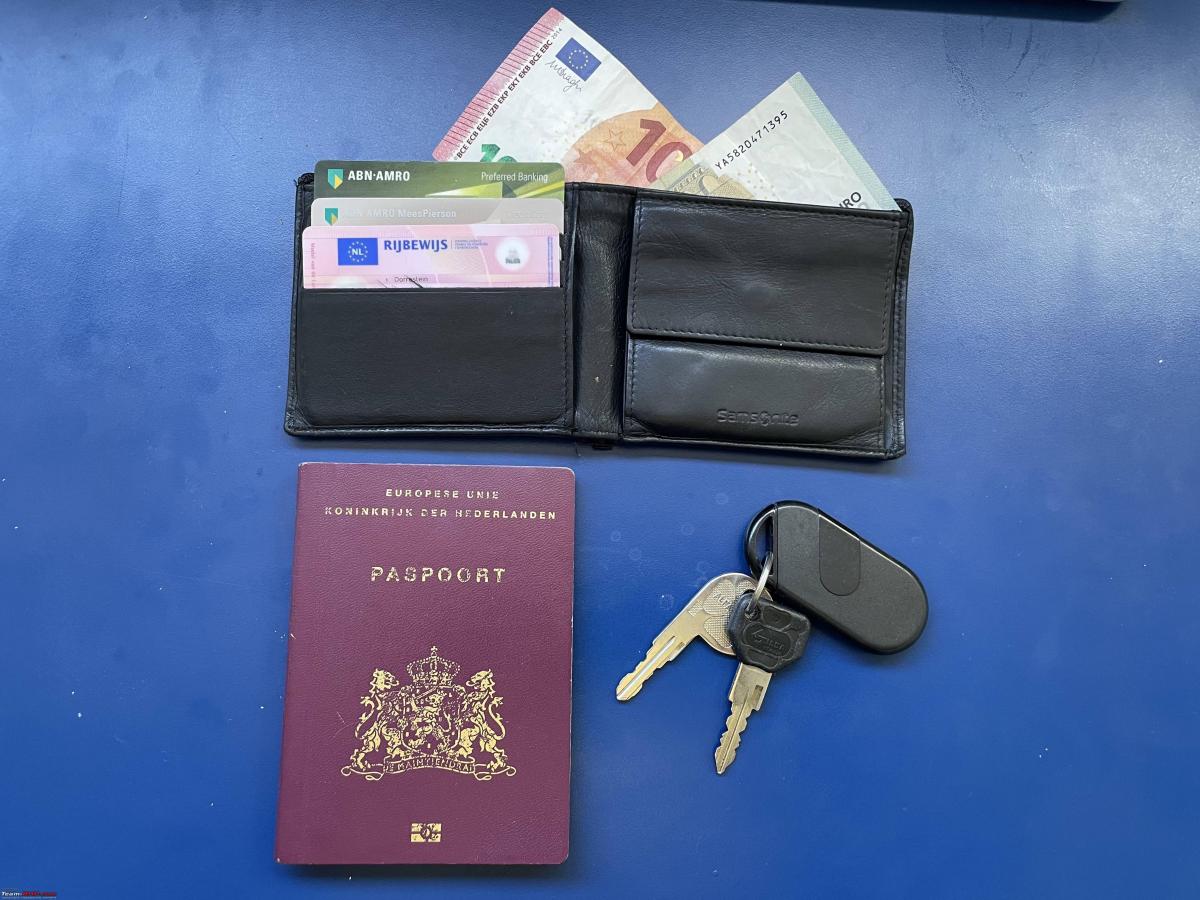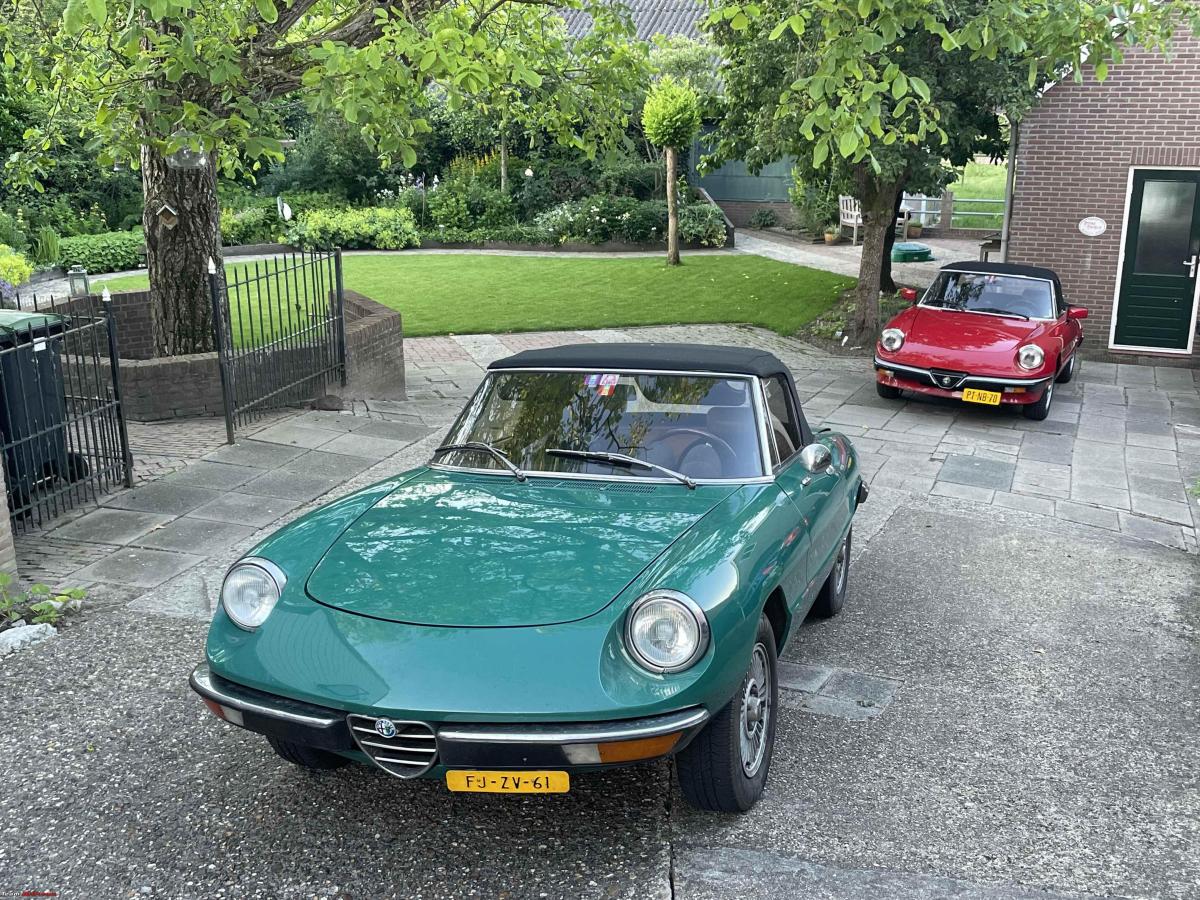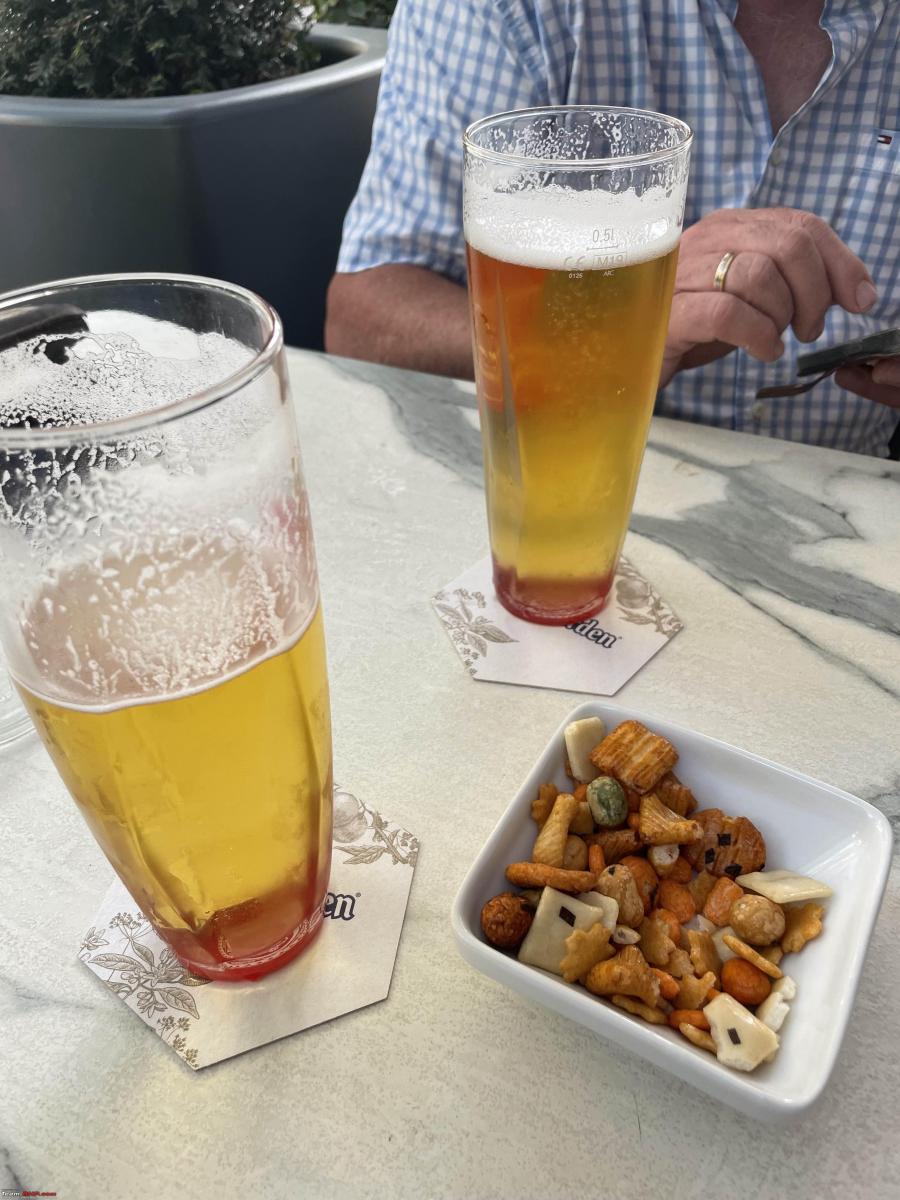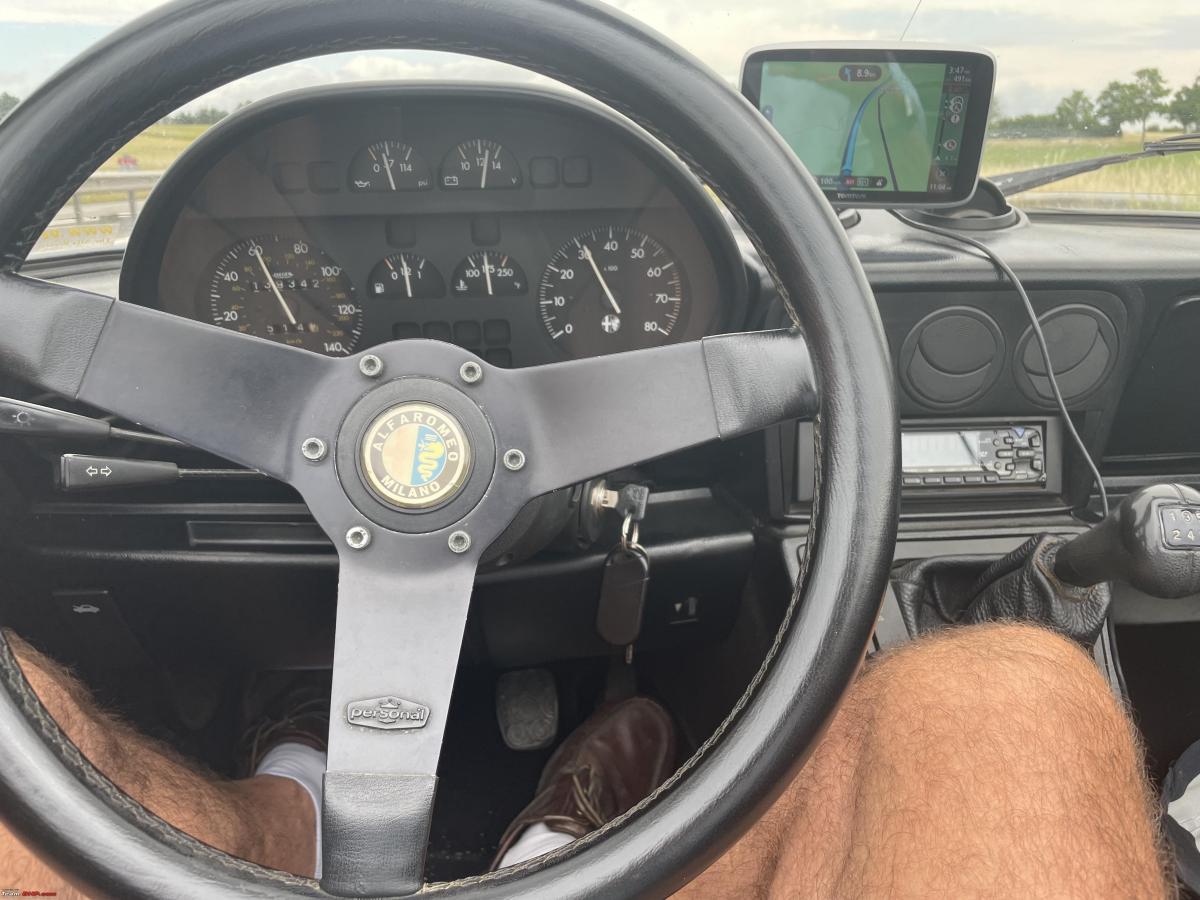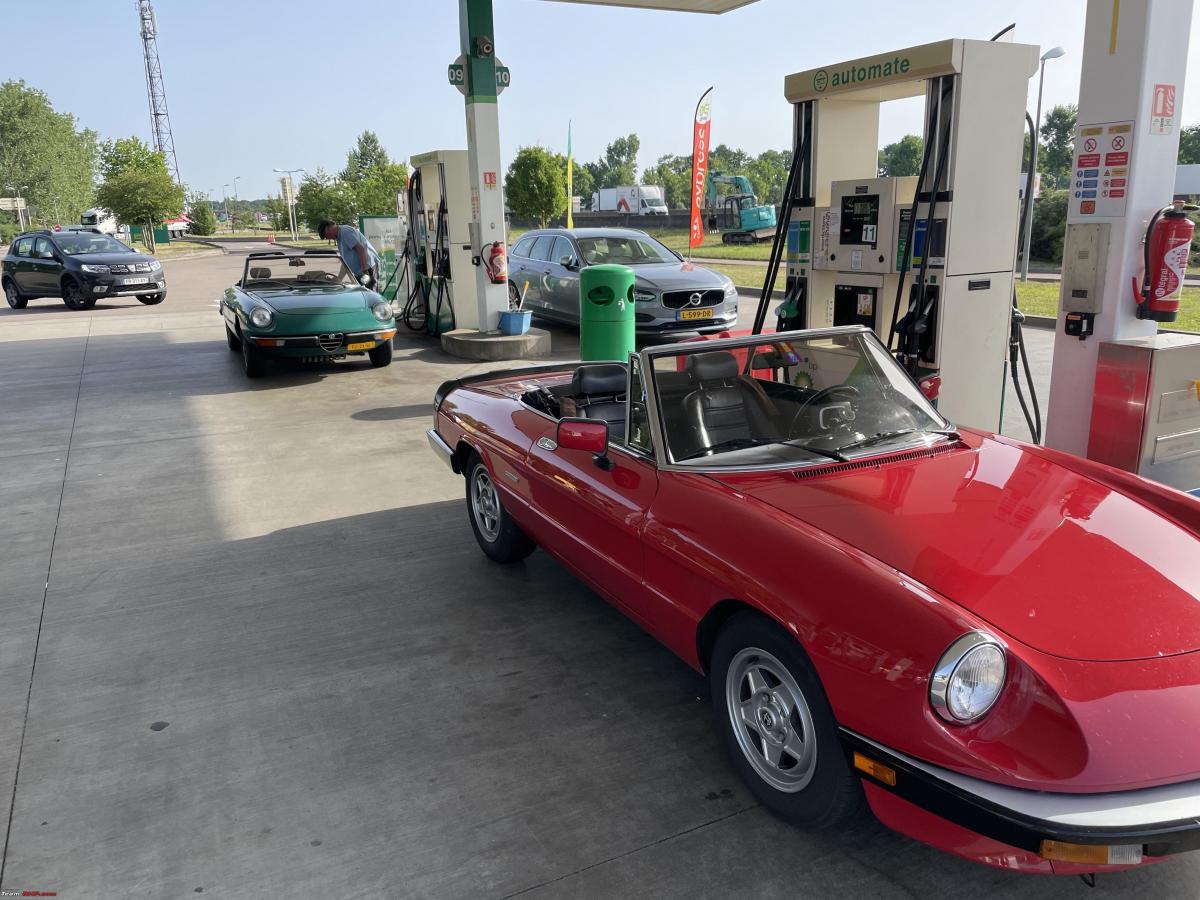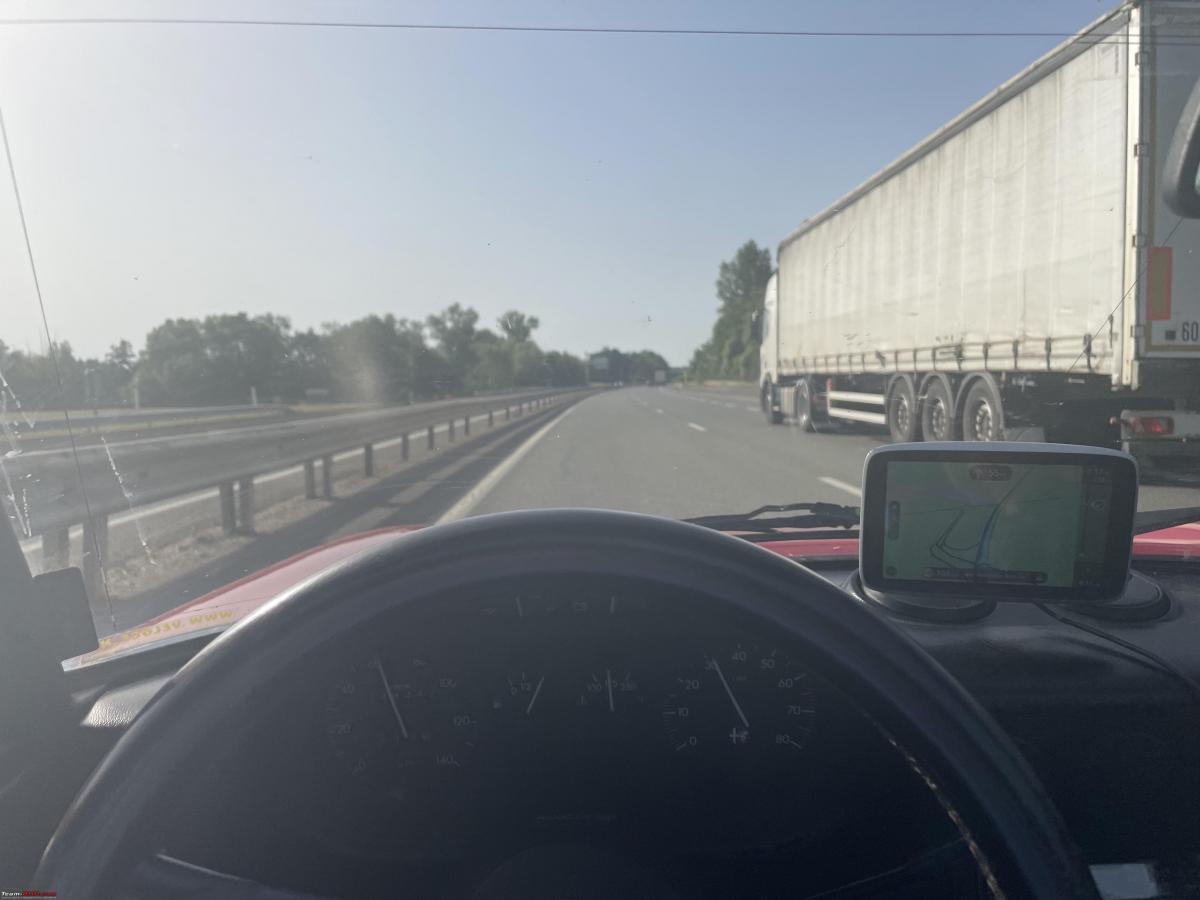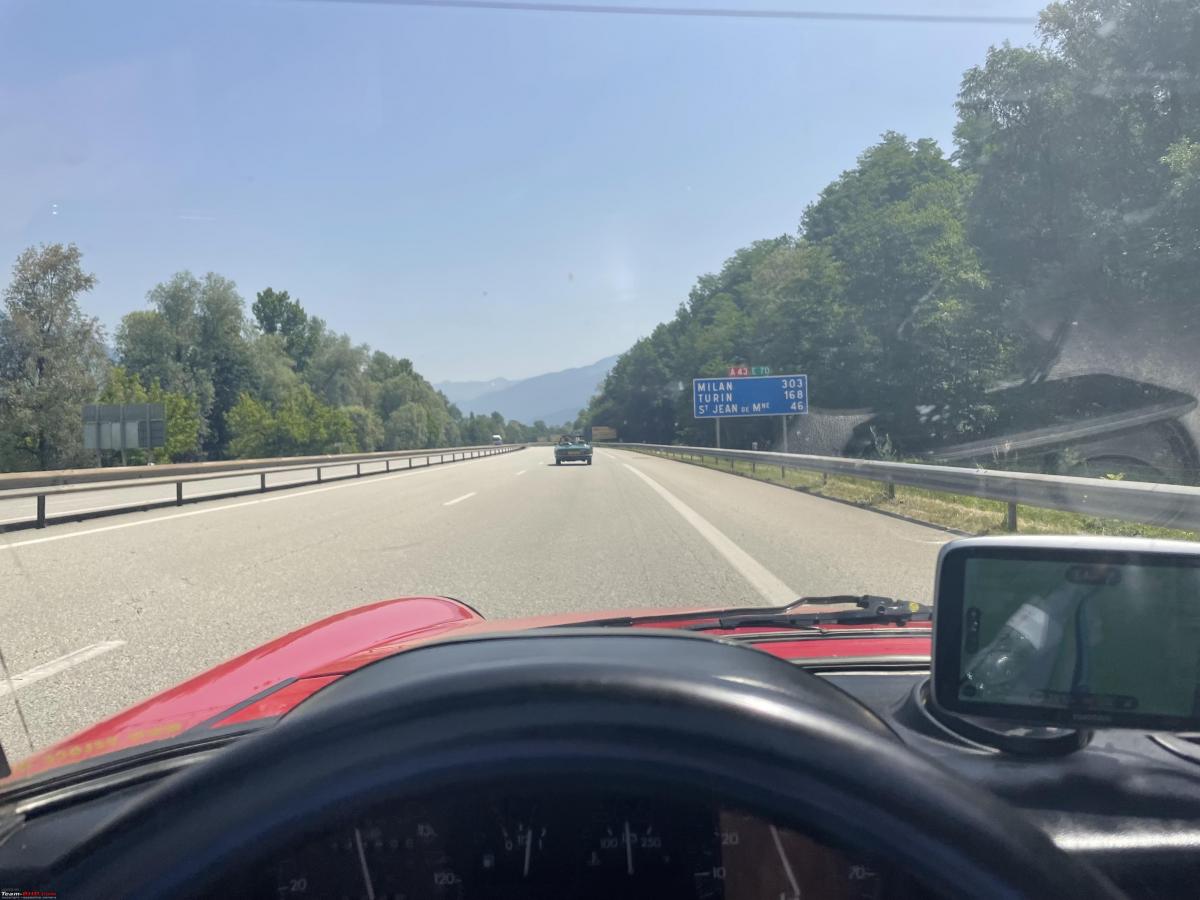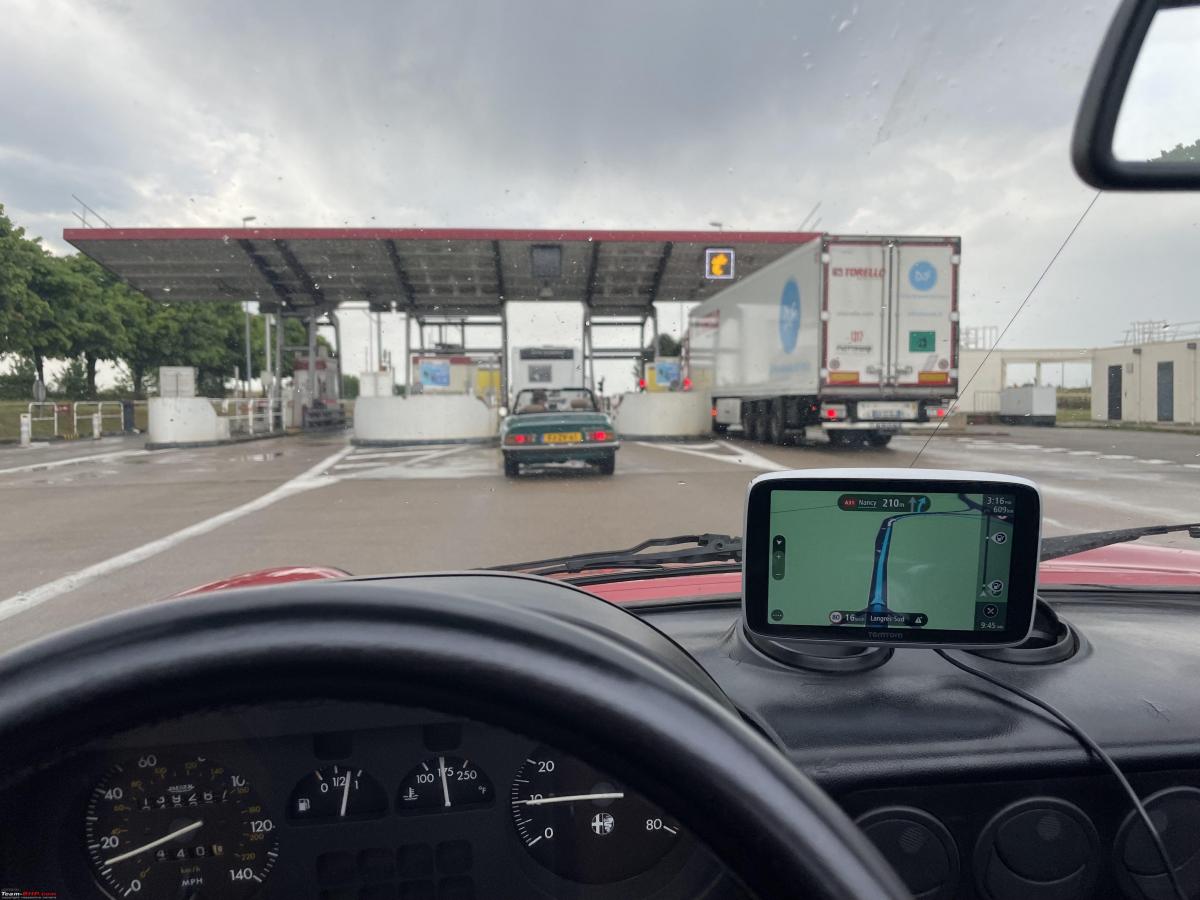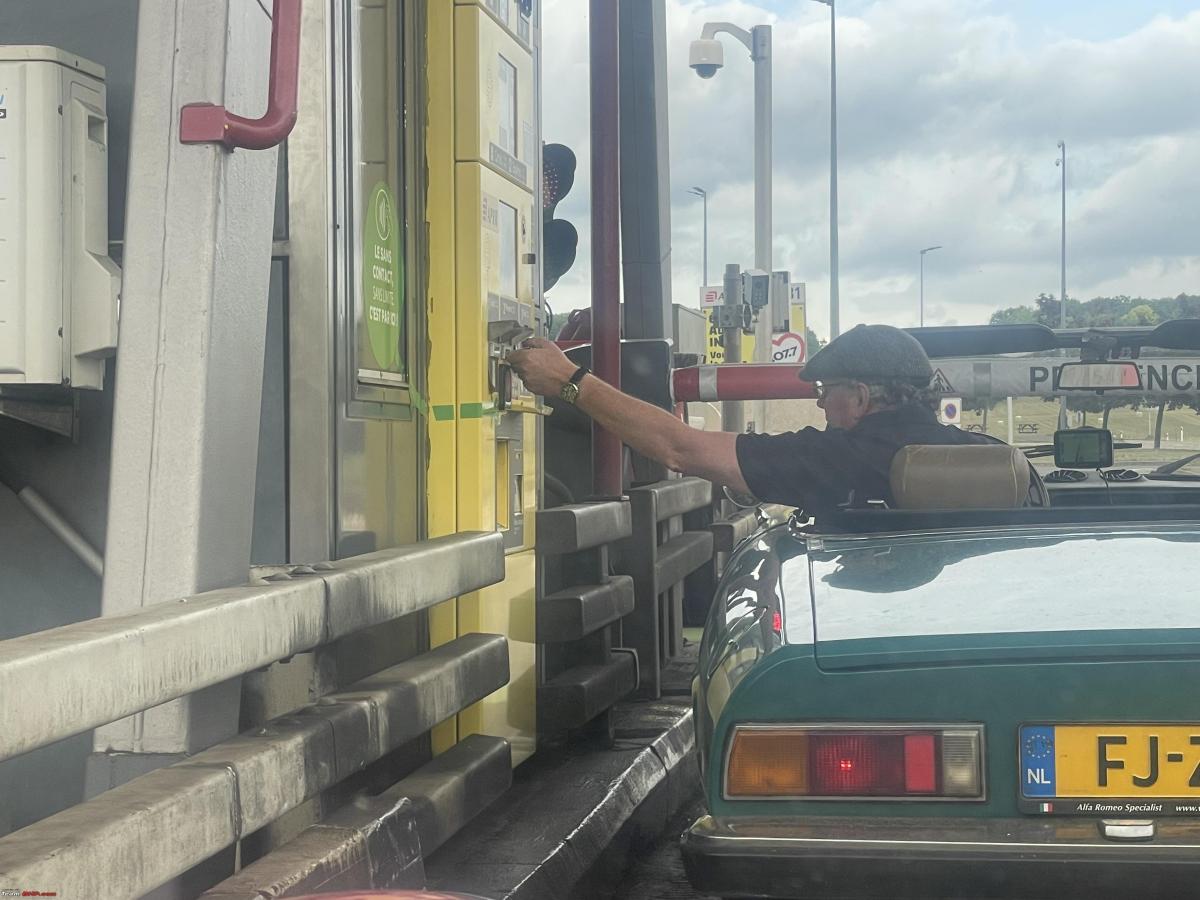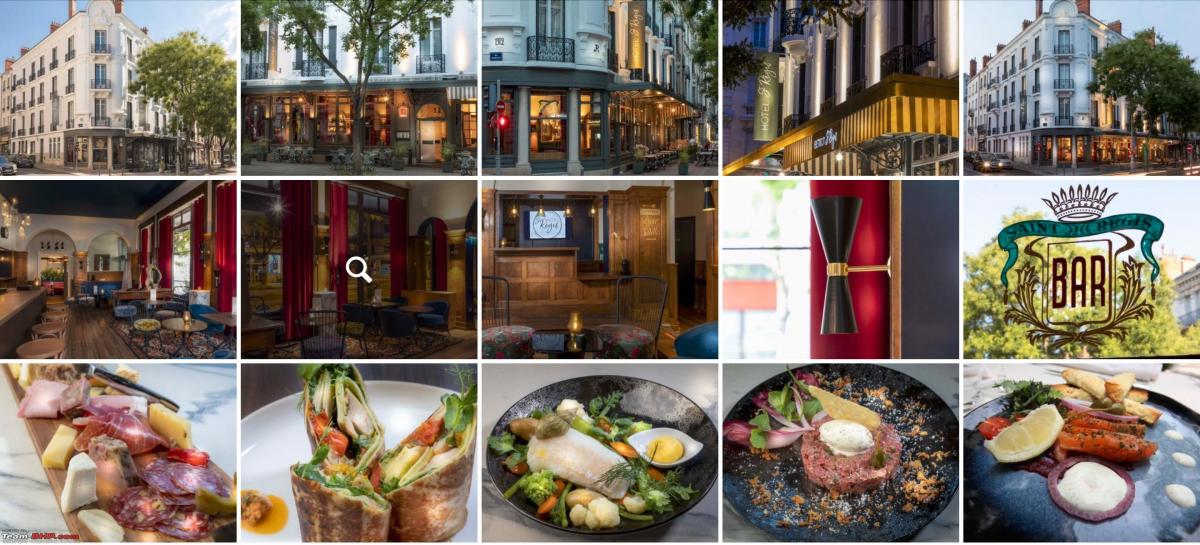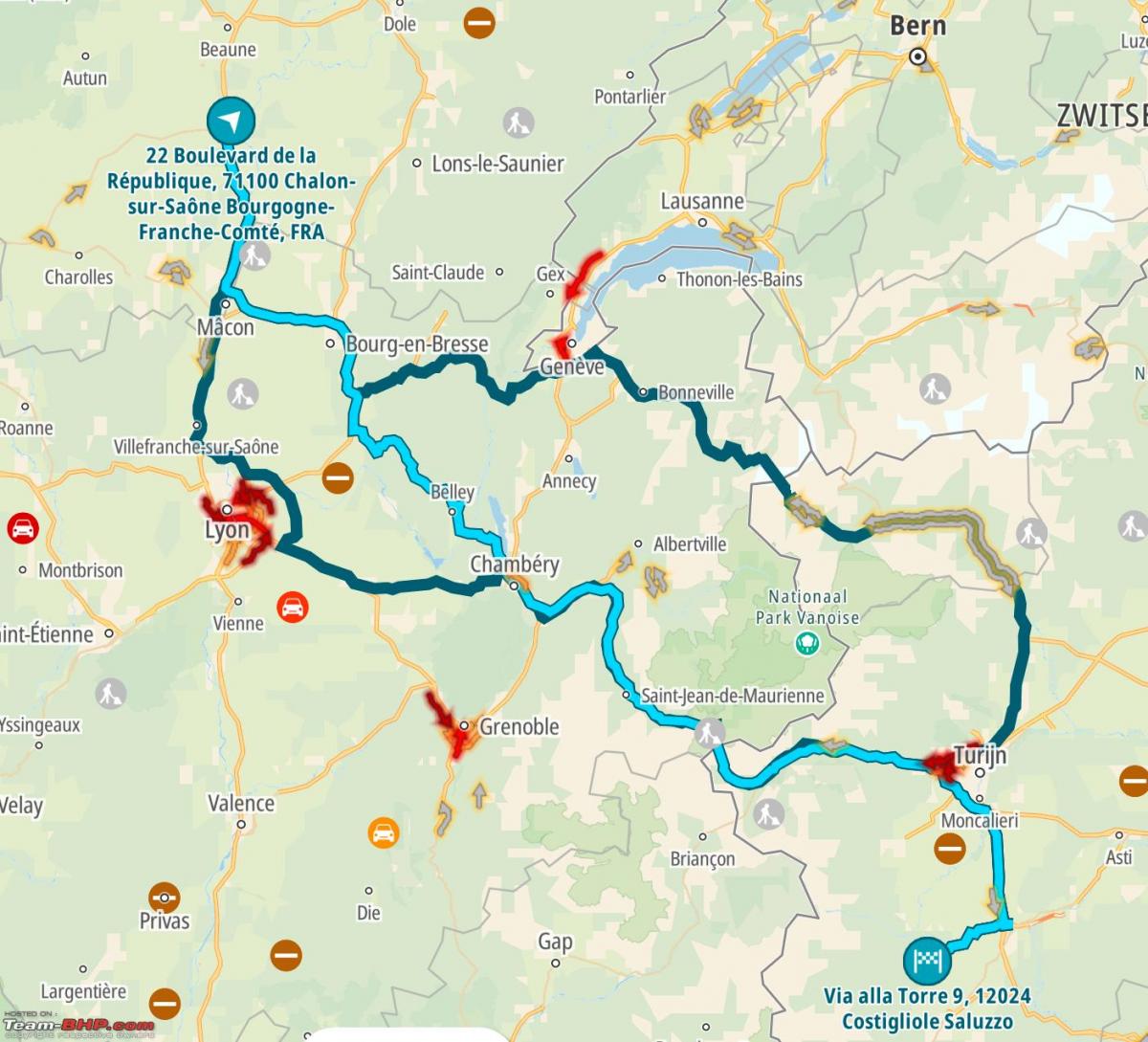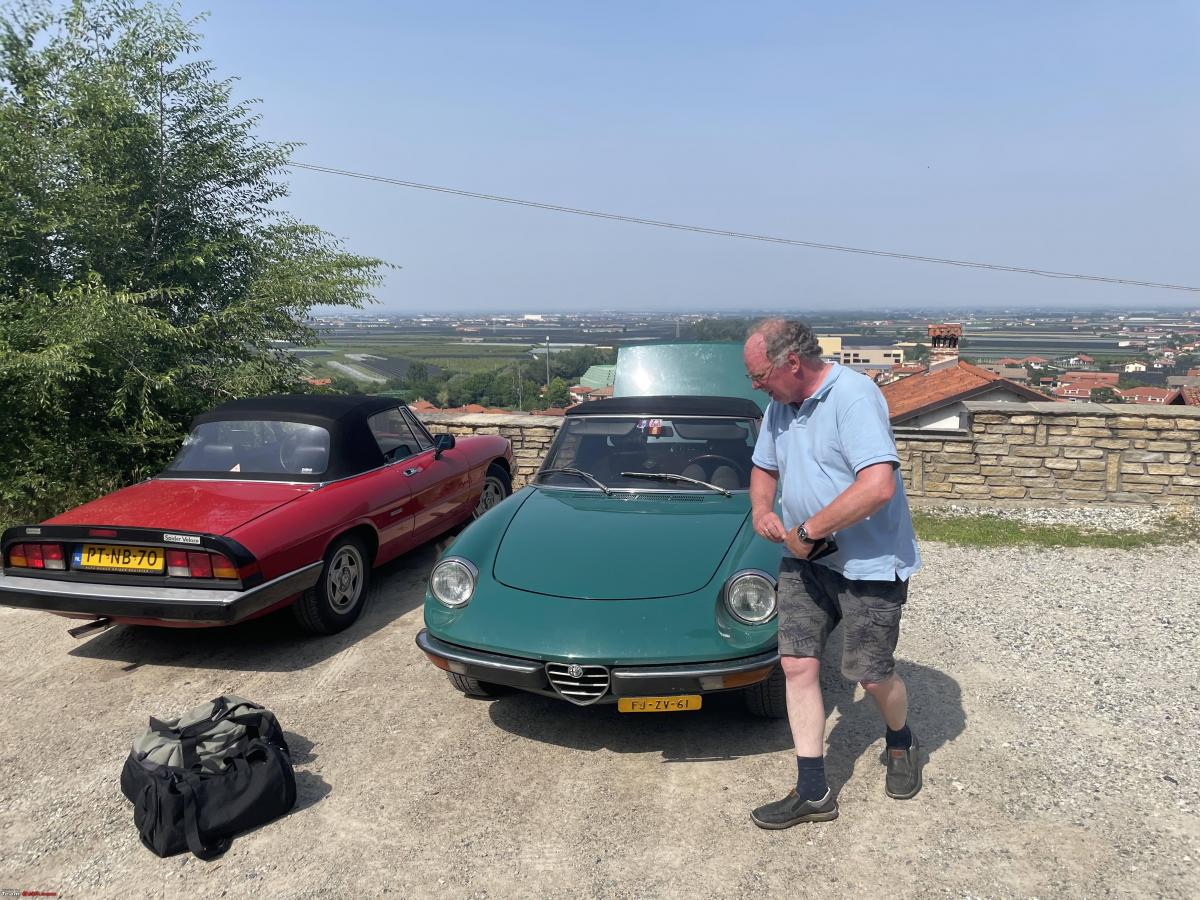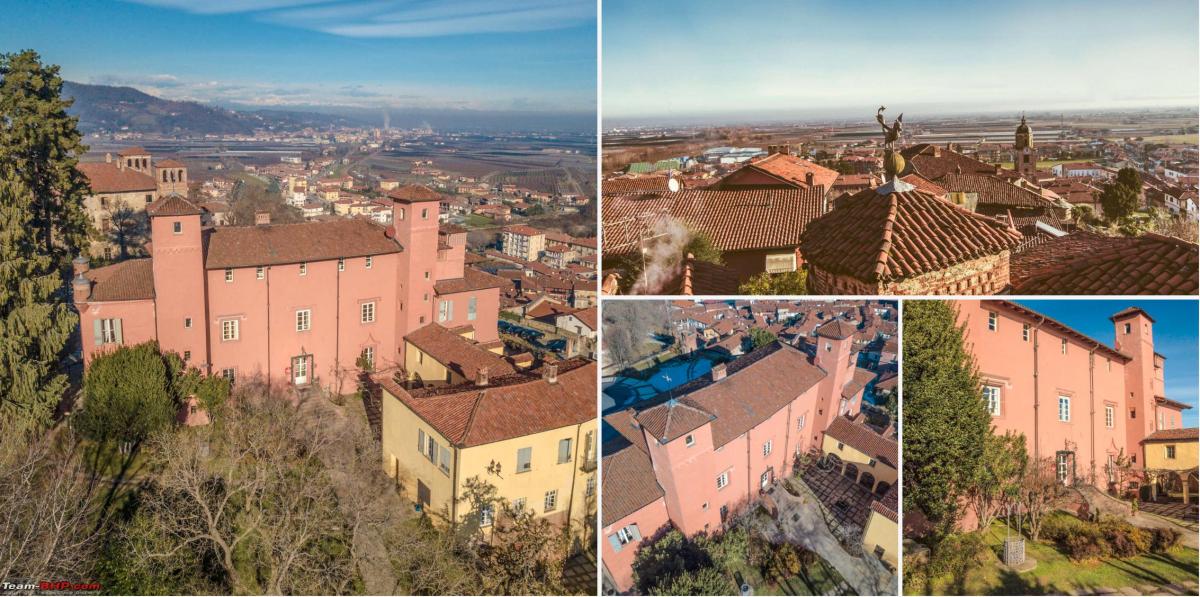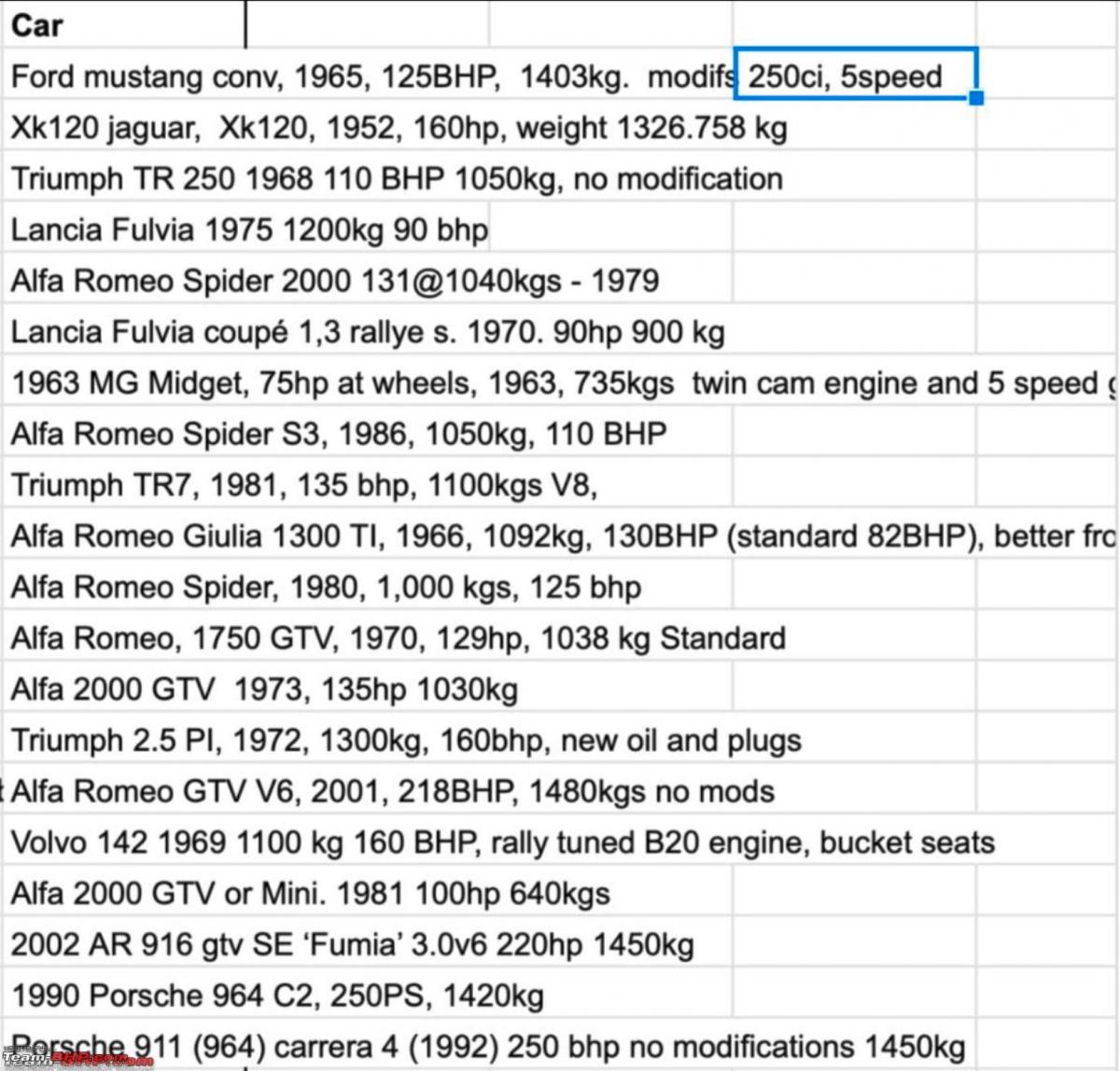I was accompanied by my friend who also has an Alfa Romeo. We had to travel ~1250 km in 2 days to participate in the unique 12in12 event.
BHPian Jeroen recently shared this with other enthusiasts.
Travelling by car in (Western) Europe is very different from travelling by car in India. It is not about what is better or worse, they are just very different experiences. We have quite a few members in this part of the world, and also members visiting from India. Although this itinerary is about a very special car event that took place on the 18th of June 2022, near Saluzzo, Italy, I will cover the whole trip to give a flavour of what it is/can be like travelling by car in Europe. I will also mention the cost of various items along the route.
This trip was our annual Alfa Romeo Spider trip with my spanner mate and very good friend Peter. I have written about some of our earlier trips before, see:
Touring the Ardennes and Eiffel
Two guys, two Alfa Romeo Spiders, several ferries – A road trip in the UK
It is a long tradition Peter and I have. For decades we will try and get away for 4-6 days every year. Just the two of us and our two Alfa Spiders. Most often we don’t have a particular destination. We sort of look at the weather in Europe and just start driving. We like to drive on small rural country roads. We never book hotels in advance. We always travel outside the very busy main summer holidays, getting accommodation is never a problem. I will explain a bit more later.
For us being out on the road, driving, stopping for a coffee, having a nice lunch, and in the evening having some cold drinks and a nice dinner, talking and enjoying each other company and driving our Classic Alfa Spiders is what these road trips are all about.
This year was somewhat different. We decided to participate in the 12in12 event. So all of a sudden we had a very specific place and location where we had to be on a specific day: the 18th of June.
Have a look here to get some idea of what this 12in12 is all about.
Basically, a sort of friendly, one-day cannonball run through the Alps, Trying to cross as many Alpine passes or cols as they are also known, in 12 hours.
This is what the intro says:
Drive at least 12 and up to 21 of the most unknown yet challenging alpine passes crossing between the Italian and French border in just 12 hours.
A Marathon for classics (some younger cars accepted by invitation) in the N/W corner of the alps.
The formula is very simple, it’s between friends, you drive the minimum of 12 passes we give you in just 12 hours.
Whilst there are many events that involve photo calls, posing and driving in lines with a nice plaque on your car this is not one of them.
THIS EVENT IS ABOUT DRIVING.
It’s not an impossible event by all means, in fact in previous events just about everyone managed to finish without any problems and one contender drove with his 13-year-old son in a pretty standard Fiat XI9.
It is an endurance event, a test of driver, navigator and car, where you will drive some really spectacular roads, crisscross the border, drive-by snow, waterfalls, tight bends, switchbacks, tight spots or where two cars can’t pass at the same time.
You will blast through tunnels and even places with some rough bits.
We have got it all.
It’s done on many of Europe’s unknown mountain passes, this is not the Stelvio with camper vans and baby prams holding everything up, here you will be higher and faster and most of the time with very little in front of you except maybe another participant.
But you can do it, you don’t need a special car really you just need the will to enjoy, although a bit of concentration and preparation doesn’t hurt.
A very small and cost-effective event for classic (or special interest) cars, with a high social flavour and which is by invitation only.
Sounds like what you’re looking for? Then don’t forget to drop us a contact at the bottom of the pages to keep updated.
Sounded right up our sleeve! Our Spider friend Niek had participated last year, so we got some excellent intel from him, prior to us setting off.
There was just one thing, driving to the starting point is about 1250 km, almost all motorway. And we had to take the motorway, neither Peter nor I could take sufficient time off to allow a more scenic, rural route. Peter and I had been doing a bit of planning on our TomTom’s a few weeks earlier.
There are several routes we could choose from:
Of course, knowing your way across Europe is helpful when deciding upon which alternative to take. The quickest route, in theory, is via Germany. But we know from long experience there will be a lot of road works along the route. Also, you will find yourself driving through the Ruhr area, not very pretty.
So we decided upon the route that would take us from our home, Antwerp, Brussels, Luxembourg and then take the so-called Route Du Soleil south to just North of Lyon where we would start heading east and enter Italy through one of the imposing Alp tunnels.
We had two days to get to the starting location. We wanted to arrive mid-Friday afternoon, which meant setting off early on Thursday morning. Peter drove down to our home on Wednesday evening, as he lives about an hour and a half north of us.
Of course, prior to setting off, we had done a bit more preparation on our cars. Obviously, it does make a difference, whether you are driving a modern car, or two old classic Italian rag-top sports cars. These Italian cars might look great, but they were not that well built to start with, bits fall off en route, and other bits might stop working, so you need to be prepared.
Peter and I always carry a large number of tools and parts with us. However, this would be a journey which would put our little Spiders under considerable strain. Lots of mileage in a short period and mountain driving too. So we got ourselves some additional spare parts. Peter and I used to be on the Technical Committee of the Dutch Alfa Romeo Spider Register, so we know a lot of people in the Spider community. Peter got us a complete spare parts kit free of charge, we only pay for the parts we would use. Everything else we just return after we come home again.
More about these parts later, spoiler alert; we still found ourselves short of the correct part!
Always carry lots of water and a tow rope! Driving in a rag-top sports car, top-down in the blazing sun is thirsty work!
My usual set of tools and box with many useful bits.
And some more odds and ends. Watch that distributor assembly! It was to play a crucial part! And as you will find out, I should have had a much closer look at it. If you zoom in on it, you can actually spot the problem.
Some other crucial parts when driving an open car – a cap and sunblock!
I have two caps. The one on the left I have owned for almost as long as I have owned my Spider. It is tethered to my driver’s seat. It is what I call my high-speed motorway cap. I have tried any number of hats and caps. But very few will stay on when you are driving 100 – 120 km/h top down. This one does! The other cap on the right is my rural driving cap. It is more comfortable, but only up to speeds of about 90 km/h.
You do want to wear a cap when driving an open-top car for at least two reasons; One is that the hair on top of my head is not as lush as it once used to be. So my skull is exposed to the sun! It needs protection. Also, a cap really protects your eyes. Even when wearing sunglasses but no cap, your eyes will tire out quickly in the bright sun.
Also, according to my daughter, all old gits in a classic sports car should wear caps. It’s the rule! So there you go!
There are a few other things you need to take with you when travelling/driving through western Europe.
Obviously, passport, driver’s license and car papers. In Europe, you will need to have your car registration papers and proof of insurance with you. The latter used to be called the green card. Because they were printed on, Duh, green paper for some reason. These days the insurance company mails it to you and you need to print it yourself, so white, not green. But it is still known as a “green card”.
On these long trips I also always take a spare set of keys. Very early on in our marriage, I asked my wife to keep the spare set during a road trip. Upon returning home she had lost them! As not to stress our marriage any further, I look after the spare set myself. I usually stick it into one of my carry-on bags.
Lastly; money, the real paper deal and the plastic ones. These days in countries such as the Netherlands, Sweden, Germany you can do without cash, certainly in all the main cities. But when you find yourself in rural France or in a remote village on an Alpine pass in Italy, the local petrol station might not accept any cards! So better bring cash, small denominations and coins too. When you travel in western Europe you will be fine with Euros. Switzerland still has its own currency. But we were highly confident that the Swiss would have perfected all possibilities of electronic payments in any imaginable location all across Switzerland. So we did not bother with Swiss Francs. The Euro cash is primarily for rural France and Italy, just in case.
So I bring my regular Dutch Bank direct debit card and a Master Credit Card. The direct debit bank works just about everywhere in Europe these days as well, even contactless. Just a tip for those of you who might want to visit the Netherlands, you will be surprised (but not pleasantly) by how few shops and businesses in the Netherlands accept credit cards. You can’t buy food in a supermarket or even pay for fuel by credit card might be problematic!
I always bring two simple canvas bags when touring in my Spider. Canvas rather than my normal trusted Samsonite roly-poly hard case. The canvas bags are easier to store and cram into the boot. All my clean clothes and everything else goes into one, whatever has been used / dirty stuff goes into the second bag. Very simple, very effective, at least for me.
And of course, a mobile phone with a good international data package is crucial! You will see why, later on.
Obviously, the Spider needed a couple of things checked as well. I keep it in really good condition, so it is ready to roll any time. But prior to such a long tour I usually do a few checks. Check tire pressure, including the spare. I keep the spare tire about 10-15% above the normal pressure to allow for some air to permeate out over time. Double-check oil and coolant. Give it a good wash, wax and hoover. With all the tools and parts, it’s ready to roll!
There was one final preparation I had to do; On the Saturday night, after the completion of the 12in12, there was going to be a party, announcement of the winners and so on. All participants were requested to bring some local beer, so we could all sample each other’s beers.
So I went off to our local off-licence. To stay in line with TeamBHP policies on drinks, I have taken a photograph of the non-alcohol variant. Three very local beers, from three different towns here in the Netherlands.
I could have brought Heineken, but the Netherlands has a thriving small/local beer industry. So I thought would be nice to bring something a bit more unusual.
Peter arrived on Wednesday evening at around 21.30 at our place. I had already moved my Spider out of the garage. It involves shunting four cars around the yard and onto the dike. Did not want to go through that hassle early in the morning.
This is the only time you will see our Spiders with the hoods up; at night, parked!
Peter and I had a quick (alcohol-free) beer to discuss the final details of our route.
We decided to have breakfast at around 07.00 and be on the road by 08.00 latest, if not earlier. We also checked the weather forecast one more time. Subsequently, we double-checked the amount of sunblock we had brought! It was going to get hot!
We would have two days to drive about 1250 km. We decided that we wanted to do about 800 km on the first day.
The following day we were on the road by about 07.30. This would be my office for the next six days!
Traffic around Antwerp seemed even worse than normal. Normal traffic around Antwerp being pretty bad as it is. Our TomTom’s Traffic information system gave us a few detours, which added some 50 km to our total distance, and still saw us stuck in traffic on the Antwerp ring road. Luckily getting around Brussel was pretty easy.
Peter and I used to drive our Spiders at 3500 RPM on motorways. That would get us about 120 km/h. But both our Spiders and we have gotten a bit older. So these days we tend to cruise a bit slower, about 3100 RPM, doing 100-105 km/h.
It makes cruising a little easier. The noise and the wind in these little sports cars are something else. Add 10km/h and it increases exponentially.
After having driven tens of thousands of kilometers all over Europe we have developed very simple routines, that work for us. We always program the routes into our own TomTom. Then we check that we are getting the same distance and ETA. If not, and it happens, we check where the route in one TomTom differs from the other. We drive in a little convoy, one of us up front, one right behind. We have developed some hand signals to communicate about stops, when overtaking etc.
We usually drive about 1,5 – 2 hours and stop for coffee / toilet / fill up with petrol. After each stop, we swap who drives up front. Here in the Netherlands I usually run all my cars till I get a reserve fuel indication on the dashboard. There are petrol stations everywhere. Also on motorways, you are rarely more than 10-20 km from a petrol station.
Certainly on French motorways that is not always the case. You might find yourself on a stretch of motorway with 100 or more kilometers between petrol stations! And not too many exits in between either! Luckily, in countries such as France, at the signs for each petrol station, they will also list the distances to the next two/three petrol stations. Even so, we just fill up at every stop.
Soon this would be a very familiar sight:
Peter’s Spider is a 1980 Serie 2 Coda Tronca, mine is a 1986 Serie 3 Aerodynamica. Peter has twin carburettors, mine has Bosch L-Jetronic injection.
Although there is not much difference in power, my Spider uses about 20% less fuel. I am doing about 1:11 on the motorway at these speeds. We had no trouble getting E5 petrol in France or Italy. We don’t care about octane 95 or 98, but we do care a lot about the fuel being E5 and not E10. A lot of the Octane 98 is still E5. The Octane 95 often is E10. It differs a bit from country to country though. Always check. Our Spiders can’t handle E10. In all honesty, if push comes to shove we would have put E10 in too. Because it would be used up in a matter of hours, so it is not really a problem. But we avoid it if we can!
Prices across France, Italy, Switzerland and Belgium varied between about Euro 2 to Euro 2,35 (INR 164 – 193). Not cheap, but still (a lot) cheaper than petrol in the Netherlands!
Of course, driving all day on motorways is a bit boring:
But the further south we come, and once we entered the Route Du Soleil, the scenery becomes very pleasant:
Large sections of the Route du Soleil are toll roads. Also throughout Switzerland and Italy, you are likely to find yourselves using toll roads if you want to make good time. Yes, you pay a fee, but most of these toll roads are well maintained, have good facilities, other than petrol stations, you will find restaurants, rest stops with toilet facilities, picnic tables, children’s playground and so on.
These days I am a bit challenged by things like ATMs, Computers, parking meters and so on. These toll booths are worse for me. Because they will have machines talking to you in French, or worse in Italian. Sometimes you have to push a button to get a ticket, sometimes the ticket appears automatically, sometimes you pay as you enter, and other times you need to push your ticket in a particular slot and a credit card in another slot. I have some problems with certain cognitive functions so these sorts of things can cause some anxiety. Usually, Peter would drive up ahead and I could watch what he did. Take a ticket, or push a button, or shove a credit card into the machine. Once the barrier was raised for him, he would drive through and wait right behind the barrier to ensure I got through too.
Toll charges vary a lot. We paid Euro 1,50 (INR 123) for a short section in Italy. These bits in France were usually around Euro 15 – 25 (INR 123 – 205). But they were fairly long stretches. In all, for the complete round trip, we must have spent a little over euro 200 (INR 16500) in toll alone. The most expensive ones are the two major, 13 – 17 km long tunnels. On the way down we crossed from France into Italy by the Frejus tunnel and going home we went via the Mont Blanc Tunnel. Each cost a staggering Euro 48 one way! (INR 3950).
Around 1600 hours we had another stop. Filled up with petrol, as usual, had a bit of a leg stretch, and drank some water. We discussed our progress, which was pretty good so far. We always take our TomTom and mobile phones to where we are going to have coffee. So we check the route, make adjustments, and check weather updates en route. And around 1600 hours it is time to decide where we are going to haul up for the evening. We felt we wanted to put in some more miles. The more we did today, the less we have to do tomorrow.
So we use Google maps and look for nice small provincial towns along the route. We don’t want anything directly onto the motorway, just not too far away though. We tend to look for old historic towns, something with a citadel or a nearby castle, church, or monastery usually does fine. Because it will mean there are likely to be some restaurants and hotels and usually some nice local streets and squares to wander around. We decided on Chalon-sur-Saone. Whilst I was checking the tourist information getting some intel on where to go / what to see perhaps, Peter was already checking for vacancies in a decent hotel, near the town centre. We just about always use Booking.com. Very convenient app. Finding a suitable hotel and making an online booking is a two-minute process, if that. Very convenient.
Peter and I never keep track in detail of who pays for what. One-stop he will pay for the coffee, the next I would pay. He pays for the hotel, I would pay for the dinner, drinks and breakfast. We sort of keep a mental tally, but it’s more by guts and feel and knowing neither of us wants to put the other out of pocket. Very convenient and it has worked for us for several decades.
So we jumped back into our Spiders, punched in the hotel address into our TomTom and drove another two hours and into the town centre. Parked near the hotel to unload our luggage and check-in. The hotel did not have parking facilities, but there was a proper parking garage just around the corner. So we went back to our Spiders to park. However, Peter’s Spider would not start. Those of you who follow my “fiddling with cars” thread know we had problems with his Spider before. Last year on our annual drive we had similar problems. Since Peter has replaced the starter motor and added a relais. It had been starting fine a few weeks earlier on our annual Spider Tour to France. We were tired and we just could not be bothered to check what was wrong. We decided to simply push start it. We know from experience, that with the engine properly warmed it starts very easily. With Peter in the cockpit and me pushing that should work, we have done it before. But no luck this time. We had to rope in the assistance of a French guy and it started fine. Later that evening, after a few beers, Peter confessed he had left the hand brake on during my first push start attempt. I thought it was a bit heavy, but I thought I was just tired.
We stayed in the Hotel Saint Regis.
Per person, one room each and breakfast we paid about Euro 115 pp (INR 9450) which for this kind of hotel at this sort of location is a very decent and going rate in most of Western Europe.
We had a quick shower and met up at the hotel terrace. We always like to have a few cold drinks after such a long drive. We felt really tired, the menu looked quite good so we decided to have dinner here too. We were just too pooped out to look for a different restaurant. Turned out the food in the hotel restaurant was very good. We really enjoyed it. Very amicable and knowledgeable staff. We do speak a few words of French, Peter a few more than me. But these days, many French will manage in English. But they always appreciate foreigners trying to speak French. Of course, in these sorts of rural provincial towns, the menu card will always be in French only. Bring your phone so you can use Google Translate. You don’t want to be confusing snails for steak! (I love French snails!) Afterwards, we went for a little stroll and turned in at about 10.30 pm.
The next morning breakfast was at 07.30. In the breakfast room, we were approached by three young Dutch ladies. They had been sitting across from us in the restaurant the night before. They wanted to know if we were the guys that were driving those “old red and green cars”. Yes, so we confirmed. It appears they had been following the same route as us. We had overtaken them multiple times during the day. That happens when you stop frequently. You tend to find yourself overtaking the same cars after a while. We also overtook a gorgeous Dutch Citroen DS several times that day. The three young ladies were on a road trip themselves heading for Spain and Portugal. Their first stop was going to be Barcelona. Nice and interesting town, but I would avoid all of Spain’s main cities in the summer. It gets awfully hot and dusty.
As always, Peter and I bring our TomTom and phones to breakfast. Breakfast is where we plan for the day. Again, some different alternatives. Irrespective it would be about 500 km driving.
By about 08.15 we hit the road again. Well, not without Peter’s Spider not wanting to start. We had discussed the potential problem the night before. We could not figure out what was wrong. On our earlier trip, Peter had problems starting too. But he had a new starter motor installed. redid some wiring. Also added a relais. On the Spider the starter motor is wired/operated directly via the ignition key. Over time the electrical contacts in the ignition barrel wear out, get corroded and you might experience starting problems. Typically it gets worse in warm/hot conditions. Adding a relais to relieve the ignition barrel of high currents is a well-known simple modification you will find on many Spiders.
With the bonnet open, Peter turned the ignition key, nothing happened, but I could hear the newly installed relais click. Which almost certainly meant the problem was in the new starter motor. With Peter starting I hit the Bendix of the starter motor and it fired up right away. From here on this would be our starting ritual several times a day. Peter would get in, release the bonnet, I would open the bonnet, Peter would hand me a hammer and I would gently tap the Bendix. It only required a very very gentle tap with the wooden stock of the hammer, and it would fire up. So it looks like this brand new starter motor has a problem!! It happens.
Our second day of driving was very similar to the first. Although the roads, or rather the scenery became much prettier. As you might have noticed in some earlier images, traffic on the French motorways was very little. The further south we got, the less traffic. Sometimes we found ourselves barreling south with no other cars or trucks anywhere near us.
A word of caution though for those of you who like to experience the French (toll) motorway roads themselves. There is this French tradition called “Black Saturday”.
It’s basically where all French go out en mass and kill themselves and each other.
The French all take their summer holiday at the exact same time. All of France, all the French!! On that Saturday they all pile into their cars and head for their summer destination killing themselves and each other along the way. So whatever you do, avoid Black Saturday at all costs!! It is simply not worth the aggravation. Let alone getting yourself killed by a worked-up Frenchman. You will find yourself in monumental delays. Mile after mile of congestion on all motorways. Endless queues at the toll booth and petrol stations and toilets! Kids crying, tempers flaring! Not much fun!! Don’t do it!!
But no or very little traffic for us. We made excellent progress. Going through the Frejus tunnel was an experience too.
Apart from the huge cost, it is very very long. About 13 km. The road leading up to the tunnel appears to be just a sort of provincial road, with gorgeous scenery and a winding road. Makes for great driving. You find yourself driving towards the Alps, with big mountains with snow on top-up ahead of you!
Some of you might recall the horrendous Mount Blanc Tunnel accident in 1999. 39 people perished! Since a lot of safety precautions have been put in place. You need to ensure keeping 150 meters of distance between cars. To help you they have installed these little blue lights on the walls of the tunnel. They are set 150m apart.
I don’t do well in these very long tunnels anymore. So Peter would drive up ahead and I would follow him, at the proper distance of course. Following his rear lights and in the middle I can see his TomTom screen glaring too. A good reference!
We made it to our final destination: Hotel Castello Rosso, located about 30 km south of Turin.
Spiders parked, about 1300 km done in the last two days. With only minor starting problems on one Spider which could be solved easily by whacking the Bendix every time the engine needed starting. Hoods up, Spiders parked for the night.
Time to explore this gorgeous place.
And look at the temperature, still hot even during the evening:
This was also the first time we met the other participants in tomorrow’s challenge. A very international crowd. People travel from far to participate. We had one Swedish guy, Goran, who had driven all the way from Sweden. He spent 17 hours behind the wheel on Thursday. There were quite a few British, Belgium, German and also Dutch participants.
The classic car scene is relatively small. We have been around it for a long time. Peter being a professional classic car valuator knows an awful lot of people, he also recognised some of the cars he had valued some years ago. All for different owners at the time. So whilst we were chatting with the other owners, we quickly discovered mutual acquaintances. There were two guys in a beautiful, stunning yellow Alfa Romeo Spider Coda Tronca. We were talking to them. One of them asked Peter if he knew his wife? Which seemed a bit of an odd question at first. But he had shown his wife the list of participants and she had recognised Peter from his surname. Turns out she went to primary school with Peter many many years ago. Peter was shown an image of him and her in a class photograph aged 8 or 10 or so! Small world indeed.
A lot of talk about cars, of course, fixing cars, repairing cars, finding parts, insuring cars etc. It also became apparent that a number of the participants had been on this 12in12 before. Some bring specially prepared cars and try to improve on their previous time. All in all quite an interesting lineup of classic cars:
Continue reading Jeroen’s road trip experience for BHPian comments, insights and more information.
Source: Read Full Article
